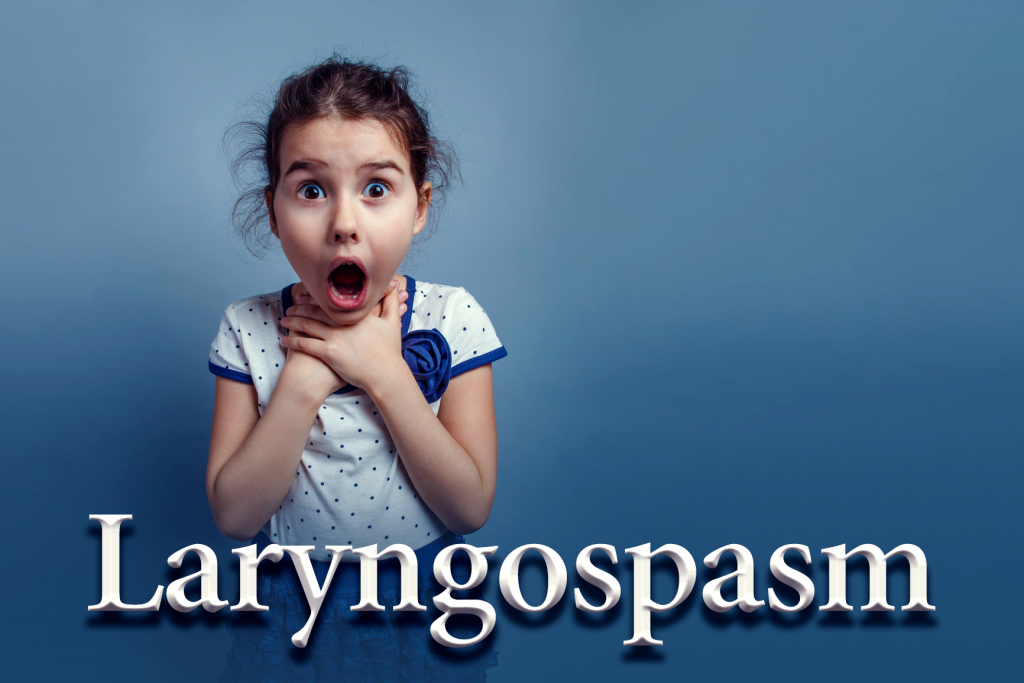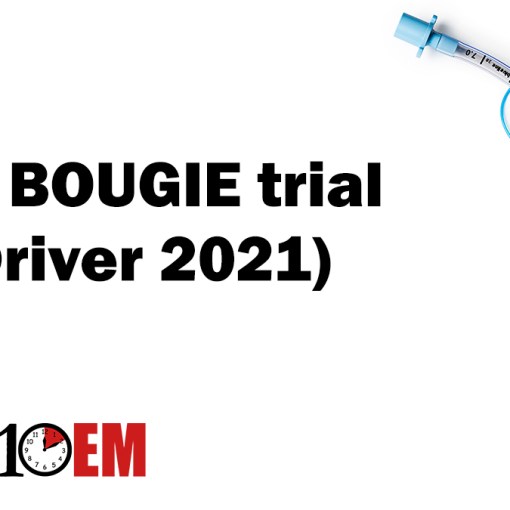It has now been a full year since I started First10EM. Thank you to everyone who has helped me a long the way, and especially to everyone who has spent their time reading this blog. I never imagined that so many people would be interested in my emergency medicine education project. This is an updated version of the first ever post on First10EM.com
Case
A feisty 3 year old tripped, cut her lip, and is now politely refusing your colleague’s attempts at suturing. You hear these polite refusals from across the department and wander over to offer your help with a procedural sedation. After moving to an appropriate room, going through the pre-sedation checklists, and tracking down all the folks that are required to be present, you give a dose of ketamine. Just as you are about to entertain the room with your latest cheesy joke, you hear a loud squeaking. You glance at the patient and recognize significant respiratory muscle contraction and stridor. A quick glance at the monitor shows a flat CO2 tracing. Oh no, laryngospasm…
My approach
Immediately stop all procedures.
The key to reversal is application of CPAP with good basic airway maneuvers.
- Apply a modified jaw thrust maneuver, where the pressure is applied near the top of the ramus of the mandible in the “laryngospasm notch” aka “Larson’s point”
- Using a bag valve mask with a PEEP valve and 100% oxygen, provide continuous positive airway pressure
While providing CPAP and applying pressure to Larson’s point, I ask my RT to prepare my intubation equipment for a potentially difficult airway. A nurse is asked to draw up a paralytic (either succinylcholine 1.5mg/kg or rocuronium 1.2mg/kg).
Key question: Is there desaturation? For the patient with already low oxygen saturation, proceeding immediately to paralysis and intubation is reasonable. If the oxygen saturation allows, start by deepening anesthesia. Propofol is the traditional agent, at a dose of 0.5mg/kg IV push.
If there is no response to deepening anesthesia, the next step is an IV paralytic. In anesthesia, this traditionally involves giving a low dose of succinylcholine to break the spasm. However, laryngospasm that is unresponsive to airway maneuvers and propofol is rare and using paralytics without intubating is unheard of in the emergency department. Personally, I think the best option at this point is to proceed with a classic RSI with a full dose of your paralytic of choice (succinylcholine 1.5mg/kg IV or rocuronium 1.2 mg/kg IV).
What do you do if you don’t have an IV? Personally, for a variety of reasons, I prefer to always have an IV in place for procedural sedation. However, if you decided to do a sedation with IM ketamine and the patient went into laryngospasm, I think the best option is to rapidly place an IV or IO and proceed with the above. Theoretically, you could give succinylcholine 4mg/kg IM, but I worry the response would be too slow for this scenario.
Extuabation is a risk factor for laryngospasm, so if you end up intubating a patient, I would consult with anesthesia to discuss the management plan.

Notes
The rate of laryngospasm in emergency department procedural sedation is about 1.1 per 1,000 in adults based on Bellolio 2016. As you can see from her note below, there is a yet to be published pediatric review that shows the rate is 3.9 per 1,000 in children. Almost all cases of laryngospasm were in cases where ketamine was used.
The laryngospasm notch:
Image from Larson’s original paper, reproduced from LITFL #FOAMed Medical Education Resources (LITFL) / CC BY-NC-SA 4.0
There is a higher risk in children with upper respiratory tract infections and those exposed to smoking at home. This might be worth considering when choosing the ideal agent for sedation.
Gentle compression of the chest has also been described (aee Al-Metwalli reference below).
Other FOAMed Resources
Laryngospasm after Ketamine on Resus.me
The best treatment for laryngospasm is simple, fast, and free
Laryngospasm treatment options on OpenAnesthesia.org
References
Borshoff DC. The Anesthetic Crisis Manual. Leeuwin press; 2013.
Al-Metwalli RR, Mowafi HA, Ismail SA: Gentle chest compression relieves extubation laryngospasm in children. J Anesth 2010; 24:854–7. PMID: 20976504
Butterworth JF, IV, Mackey DC, Wasnick JD. Chapter 19. Airway Management.In: Butterworth JF, IV, Mackey DC, Wasnick JD. eds. Morgan & Mikhail’s Clinical Anesthesiology, 5e. New York, NY: McGraw-Hill; 2013.http://accessmedicine.mhmedical.com/content.aspx?bookid=564&Sectionid=42800551
Larson CP. Laryngospasm – the best treatment (letter). Anesthesiology. 1998 Nov;89(5):1293-4. PMID: 9822036
Orliaguet GA, Gall O, Savoldelli GL, Couloigner V. Case scenario: perianesthetic management of laryngospasm in children. Anesthesiology. 2012 Feb;116(2):458-71. PMID:22222477
Salem MR, Crystal GJ, Nimmagadda U. Understanding the mechanics of laryngospasm is crucial for proper treatment. Anesthesiology. 2012 Aug;117(2):441-2. PMID: 22828433.
Bellolio MF, Gilani WI, Barrionuevo P. Incidence of Adverse Events in Adults Undergoing Procedural Sedation in the Emergency Department: A Systematic Review and Meta-analysis. Academic emergency medicine : official journal of the Society for Academic Emergency Medicine. 23(2):119-34. 2016. PMID: 26801209
Morgenstern, J. Managing laryngospasm in the emergency department, First10EM, March 3, 2016. Available at:
https://doi.org/10.51684/FIRS.1586







9 thoughts on “Managing laryngospasm in the emergency department”
Great post and import at topic.
In the 2 systematic reviews (pediatric one to be published soon) we found that the incidence of laryngospasm was 1.1 per 1,000 in adults and 3.9 per 1,000 in children undergoing sedation in the ED. Note that 33 of the 34 laryngospasms in children were using ketamine. MF Bellolio.
Thank you so much for the comment
I am not sure where I got the wrong number, but I loved the paper and also included it in the articles of the month. I can’t wait to read the pediatric version. I have updated the post to reflect the correct numbers.
Dear Justin
Enjoyed your piece. A couple of thoughts.
nobody’s got a precise definition of RSI, but I do think most agree it implies a planned sequence of steps and not a rescue oxygenation/ventilation step like getting paralytics onboard for a child with laryngospasm. You’re wording on proceeding to a “classic RSI” confuses that for me
I agree with your sentiment on always trying to get a line for sedation. Just a lot safer. However, should you end up having lost the airway and don’t have that line (or it tissued), anyone who’s cared for kids and seen them desat will agree they go blue FAST if they’re not shifting air at all. In that circumstance I think trying to get a line or IO will be super stressful and fraught with difficulty and there just may not be time. I’d consider i.m. sux which I think in practice will work more reliably and faster. Granted, this is a spectrum, a larger child with a bit of air movement not the same as the 1 yo bradying.
All the best
Mads
Thank you so much for the comment Mads.
Truly, I hope that we are debating an issue that doesn’t arise for most people. If you are doing your sedations with a well functioning IV, you shouldn’t have to worry about how to give drugs if laryngospasm were to occur.
From an emergency medicine stand point, I think that anyone who is prepared to resuscitate children has to be intimately familiar with IO access. If you are familiar with the IO and have even a small amount of practice, there is no reason that placing an IO should take longer than 30 seconds, even in children. I routinely place IOs, and even considering the time needed to take out the drill, I am sure that I can get access and push sux through an IO faster than its IM onset. That being said, if you are not comfortable with IO access, there is no reason IM sux couldn’t be used.
Like everything I post about here, I am less fussy about the specifics of your plan, as long as you have a plan thought out ahead of time, so that you don’t have to make it up with the dying patient in front of you.